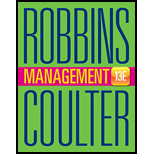
Management
13th Edition
ISBN: 9780133935813
Author: Stephen P. Robbins; Mary A. Coulter
Publisher: Pearson Education (US)
expand_more
expand_more
format_list_bulleted
Question
Chapter 5, Problem 19DQ
Summary Introduction
To explain:
The problems that will have to be faced by the telecommunications company in recruiting female employees who are university graduates and the means by which it will be dealt by the organization.
Introduction:
The much-known telecommunications company has taken the initiative to introduce an approach where a quota system shall be followed to have a gender balance in filling up vacant positions of higher ranks. In this regard, the company absorbs women who are university graduates, as there’s a higher probability that educated women will move up the career ladder to occupy higher positions. However, recruiting educated women will leave the company with a set of issues, that must be dealt with much prudence.
Expert Solution & Answer
Want to see the full answer?
Check out a sample textbook solution
Students have asked these similar questions
Discuss the Human Resources Management (HRM) policies that would consistently and coherently support attainment of your strategic initiative. These policies might address recruitment, selection, training/development, performance evaluation, compensation, and dismissal.
Briefly describe the organization and your initiative.
Describe HRM policies you think are important to implement your strategic initiative.
Describe rewards and incentives that would be used to ensure compliance, buy-in, and effort to make the strategic initiative successful.
The Internal Factor Evaluation (IFE) Matrix, is an example of a strategy formulation tool. True or False?
Question 57Select one:
True
False
Which of the following defines what business or businesses the firm is in or should be in?
Question 45Answer
a.
National Strategy
b.
Functional Strategy
c.
Corporate Strategy
d.
Business strategy
Clear my choice
Knowledge Booster
Similar questions
- Strategy formulation, implementation, and evaluation activities occur at the following hierarchical levels in a large organization to include: Question 46Answer a. Functional, horizontal and divisional or strategic business unit b. Functional, horizontal and corporate c. Corporate and functional d. Corporate, divisional or strategic business unit, and functionalarrow_forwardDuring the Decision Stage of the Strategy Formulation framework, the focus is upon generating feasible alternative strategies by aligning key external and internal factors. True or False? Question 47Select one: True Falsearrow_forwardWhich of the following is NOT a reason to outsource non-critical activities? Question 49Answer a. Lower costs b. Flatten organization strategy c. Increase competitive responsiveness d. Increase internal bureaucracies Clear my choicearrow_forward
- _____________ addresses changes within the internal and the external business environment, and can range from strikes to natural disasters, bereavement and other occurrences Question 50Answer a. Strategic Planning b. Contingency Planning c. Disaster Planning d. Organizational Planning Clear my choicearrow_forward_____________ is the name given to the firm investing in international operations Question 51Answer a. Host Company b. Global Company c. International Company d. Parent Company Clear my choicearrow_forwardWhich of the following tools are the most appropriate for analyzing the macro-environment? Question 53Answer a. SWOT analysis b. Value Chain Analysis c. Benchmarking d. PESTLE frameworkarrow_forward
- ________________is called the “action stage” of strategic management. Question 48Answer a. Strategy management b. Strategy implementation c. Strategy evaluation d. Strategy formulationarrow_forwardWhen evaluating an organization's strategy, it is important to note that corrective actions are almost always needed except when internal and external strategic positions have not changed. The basis of any review would require the redevelopment of a: ____________________________ Question 31Answer a. Value Chain Analysis b. SWOT Analysis c. EFE and IFE Matrix d. PESTLE Analysisarrow_forward___________________refers to the process of redesigning a vertical organisation along its horizontal workflows and processes. Rather than focusing on narrow jobs structured into distinct functional departments, they emphasise core processes that cut horizontally across the organisation and involve teams of employees working together to serve customers Question 23Answer a. Workforce Configuration b. Structural Reengineering c. Business Process Reengineering d. Horizontal Configurationarrow_forward
- Alternative plans that can be put into effect during strategic evaluation if certain key events within the strategic plan do not occur as expected. Question 20Answer a. Contingency Plan b. Strategic Evaluation Plan c. None of the provided options d. Emergent Planarrow_forwardAssuring results is an attainable habit of a strategic leader only if a strategic leader is intentional in developing high performing organisations. Strategic leaders must be intentional in this because they can shape the organisational culture, or the culture may ‘manage’ the leader. One way to do this is to ______________ Question 17Answer a. Develop a Strategic Leadership plan b. Develop a Strategic Implementation Plan c. Implore levers of change d. Develop a Vision Statementarrow_forwardThis stage of the strategic management process, provides a control loop in determining the successful implementation of corporate, competitive, functional and global strategies. It seeks to ascertain the nature of the change betweenplanned strategies and its resultant emergent strategies Question 16Answer a. Strategic Advantage b. Strategic Formulation c. Strategic Implementation d. Strategy Evaluationarrow_forward
arrow_back_ios
SEE MORE QUESTIONS
arrow_forward_ios
Recommended textbooks for you
